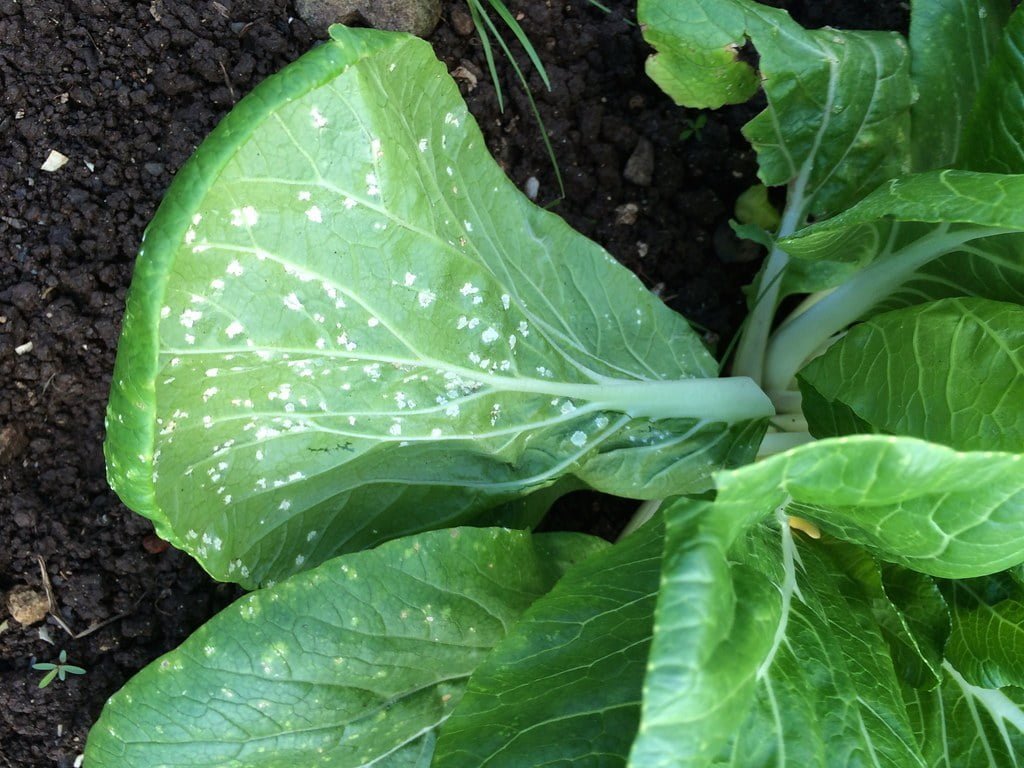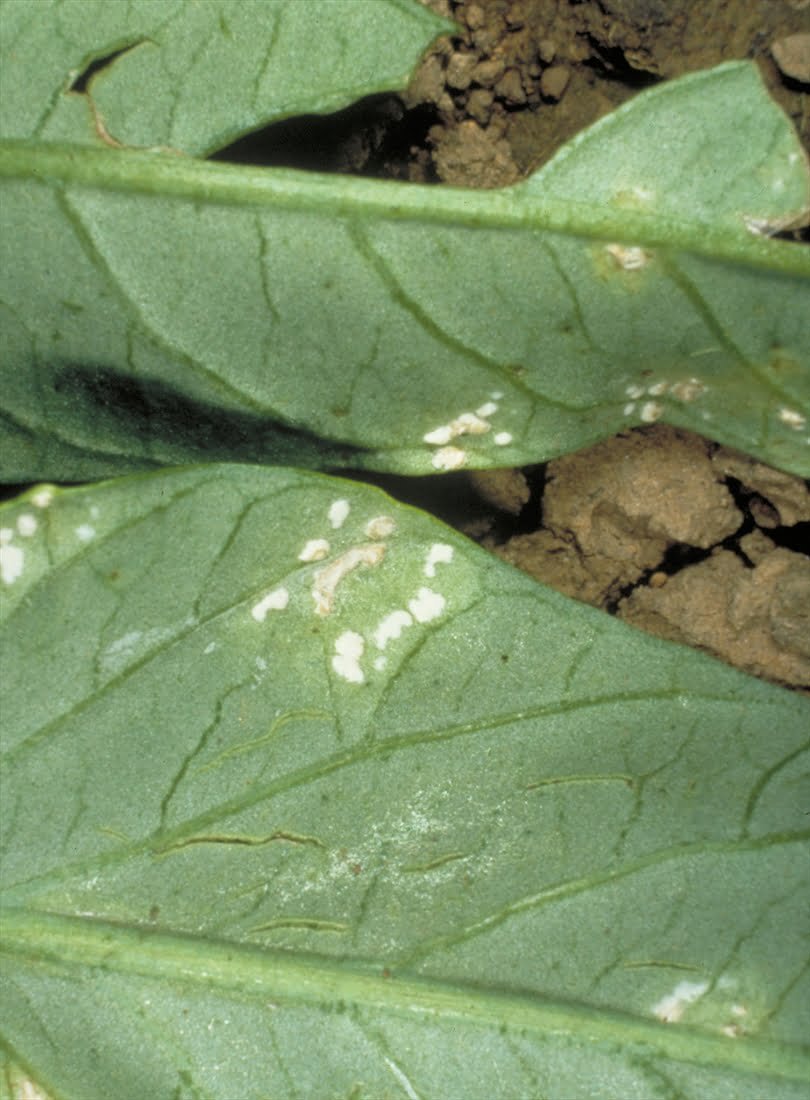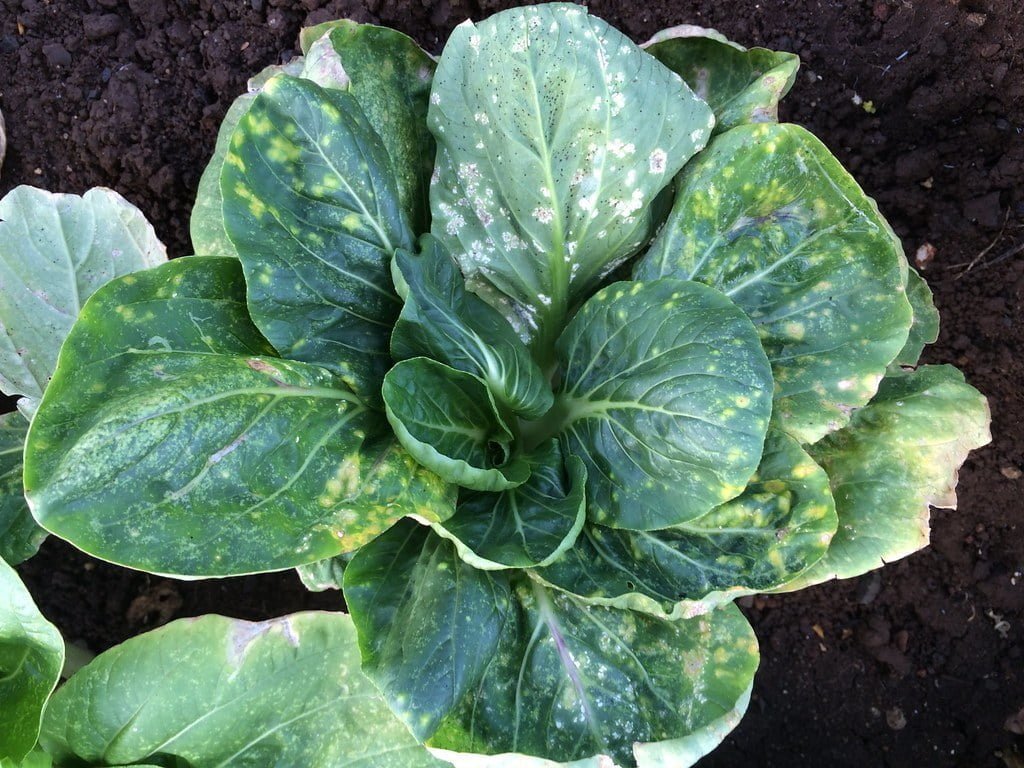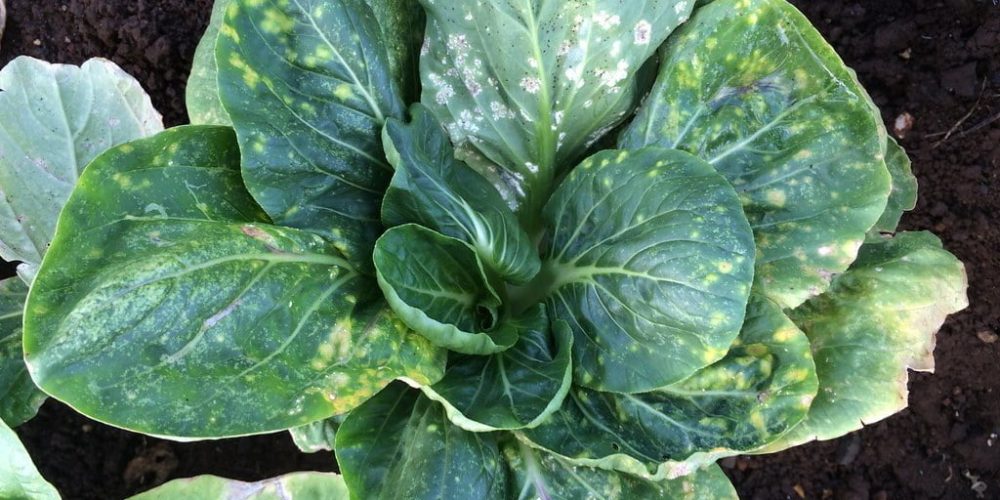Table of contents of the article
ToggleWhite cabbage rust is a fungal disease that affects the leaves of the plant and impairs its productivity. In this article from the “WORLD OF PLANTS” website, we discuss the symptoms of infection, the causes of the disease, and methods of prevention and control.
Introduction to white cabbage rust
Albugo candida: scientific name
Fungal disease
White rust disease on crucifers only economically affects cauliflower and cabbage plants. Its effect is due to the fact that it destroys the leaves, which are considered the food plant. Cabbage is also considered the economic part of the plant, which contains leaves, which makes it the most damaged plant in the cruciferous family. The fungus infects both the leaves and flower parts, and they appear as spots with white pustules that rupture at the end of the season, spreading the fungus spores again to cause infection. These germs are transmitted through air or water. Therefore, it is important to identify white rust disease in cabbage in particular and the cruciferous family in general. If this fungus is not controlled initially, it may destroy the crop and cause great loss.
Conditions for the spread of white cabbage rust
White rust spreads in the presence of moisture (90%) and relatively cold low temperatures (14-20°C). These conditions are available at the times of cabbage cultivation. The disease spreads in winter and early spring. There are types of mushroom spores that have the ability to withstand drought. It stays in the soil for long periods until it finds a suitable host to cause damage.
Geographic spread of white cabbage rust
Asia, Africa, North, South and Central America, the Caribbean, Europe, Oceania. The disease has been recorded in Australia (most cabbages), the Cook Islands (Chinese cabbage), Fiji (cabbage, mustard, swede), French Polynesia (mustard), Samoa (Chinese cabbage), and Vanuatu (Chinese cabbage, radish). Albugo ipomoeae-aquatica occurs in the Pacific Islands (Palau and the Federated States of Micronesia), as does Albugo ipomoeae-panduratae (Fiji on sweet potato, and Tonga on Ipomoea species).
Hosts of white cabbage rust
Members of the Brassica family, such as broccoli, Brussels sprouts, cabbage, cauliflower, bok choy, radishes, and cruciferous herbs. Albugo ipomoeae-aquatica (Ipomoea aquatica) and Albugo ipomoeae-panduratae (on sweet potatoes and many other Ipomoea species, as well as Convolvulus species.
The cause of white cabbage rust
This foliar disease is caused by the fungus Pogo or Pistula. In some plants, such as cabbage, white dots and powdery mildew may appear together, and the blisters contain white spores that are spread by the wind when they are released. The preferred conditions required for white rust germination range between 13-25 degrees Celsius, leaf moisture for at least two to three hours, with a relative humidity of more than 90, in addition to high soil moisture and frequent rain. The spores remain in the soil and spores on perennial grasses in the vicinity of the disease's hosts and aid in its initial spread. Secondary spread is also encouraged by pathogens being carried by wind and rain spray (spores) or by insect vectors (insects) that infect neighboring plants. It affects many species of the Brassicaceae family, but it also infects vegetables, ornamental plants, and many weeds. The spores can remain in the soil for at least three years
White cabbage rust disease cycle
Primary infection occurs due to sporulation in the soil or due to the proliferation of fungi on long-lived hosts. These serve as the primary inoculum when environmental conditions are favourable.
The oospores germinate in the presence of water to form a vesicle in which a large number of zoospores are formed. These zoospores swim in a layer of water and land on the appropriate host, germinate via germ tubes, enter the host and establish infection.
After absorbing nutrients, mycelium accumulates under the lower epidermis. Conidiophores, which are branched and formed at the tip of the hypha, begin to produce conidiosporangia in a basal succession. Compression of these breaks causes the lower epidermis to open and symptoms of white rust appear on the leaves.
Conidiosporangia produced during the early phase of the growing season cause a secondary infection in the host and are blown away by wind or other means, land on the surface of the host and germinate to form zoospores.
When conditions become unfavorable or during the later phase of the growing season, the fungus begins sexual reproduction, producing oospores, which have thick walls and can withstand unfavorable conditions.
The pathogen can be spread by many different routes including infected produce and leaves, infected crop debris, rain or irrigation spray, wind and soil, infected seedlings and/or contaminated seeds.
White rust, also known as white rust, is a fungal disease caused by the fungus Candida bujo, which infects cruciferous plants including vegetables such as cabbage, Brussels sprouts, broccoli, cauliflower and cabbage. Copperweed is also attacked.
White rust, also known as white rust, is a fungal disease caused by the fungus Candida bujo, which infects cruciferous plants that include vegetables such as cabbage, Brussels sprouts, broccoli, cauliflower, and cabbage. Copperweed is also attacked.
The infection causes characteristic chalky white lumps/blisters that first appear on the underside of leaves.
The disease causes significant economic losses due to damage to broccoli and Brassica leaf heads, resulting in reduced market value, requiring frequent application of fungicides, reducing production windows and slowing crop growth. In severe cases, it can lead to complete crop loss.
The pathogen usually occurs when nights are cool and humid and days are warm. The ideal time to plant cruciferous vegetables also provides ideal growth conditions for fungi.
Infection and symptoms of cabbage white rust
The disease can affect the crop locally and/or systemically and symptoms vary depending on the type of infection. It mainly affects plant parts that contain chlorophyll (i.e. green parts), but systemic infection can affect any part.
Symptoms of topical infection are white “pimples,” which appear in the early stages on the underside of leaves. These blister-like masses cannot be scraped off without damaging the leaf.
As the infestation progresses, light green to yellow circular areas appear on the upper leaf surface, corresponding to white blisters on the underside of the leaves. The blisters contain white powdery spores that are spread by the wind when released.
The stems and leaves of attacked crops can become twisted and distorted.
White rust also affects the flower parts. Infected broccoli and cauliflower produce severely misshapen heads and their seeds are usually sterile.
In systemic infections, the disease grows throughout the plant tissue and can be very difficult to control. Abnormal growth, deformation of infected plants, or formation of galls indicates a systemic infection.
Balls and misshapen plant parts contain another type of spore that can spread in crop debris and on seeds. In seedlings, infected plants may appear “leggy” and taller than uninfected seedlings due to abnormal growth.
When systemic infection occurs early, growth of the entire crop is checked and stunted and only small leaves may form.
The stem and inflorescence axis may twist to appear in a zigzag sequence and naturally dormant buds are stimulated to grow into side shoots.
The necessary conditions for white bubble infection are a temperature of 13 to 25 degrees Celsius and leaf moisture for at least two to three hours (from dew, fog, rain or irrigation).
Symptoms develop 6 to 21 days after infection. Severely infected plants wither and die.
 An image showing white blisters on the outer leaves of cabbage
An image showing white blisters on the outer leaves of cabbage


Management of white cabbage rust
Registered fungicides should be used in conjunction with cultural management practices as part of an integrated pest management programme. Cabbage producers should not rely on one method of disease management.
Preventive measures for white cabbage rust
- You must plant disease-free and certified plant seeds, and you must use resistant varieties, if any.
- Then plow deeply and sow early, and avoid keeping plants too close together, as this encourages high humidity and infection.
- Also make sure to clean the field well to reduce the risk of contamination.
- You should remove and dispose of severely infected plant parts.
- You should also control weeds and do other proper health measures, usually
- Three-year crop rotation with non-cruciferous host plants is effective.
- We recommend applying organic control in the early stages of the disease or when the crop is close to harvest. In the more advanced stages of the disease, please use chemical control. It is not recommended to mix or use different products at the same time.
Organic control of white cabbage rust
You should use plant extracts of neem, onion and garlic. Eucalyptus essential oil also has broad antifungal activity, and is effective against white rust in both the leaf growth stage and the head formation stage.
Chemical control of white cabbage rust
You should always consider an integrated approach with preventive measures along with biological treatments, if available. You can also use doses of mancozeb or metalaxial and mancozeb to treat the seeds. Pesticides must also be used on the soil and later on the leaves. The frequency of pesticides may vary depending on the length of the crop and the amount of rain it is exposed to. However, in temperate environments it is suggested to spray the soil and then a minimum of 1-2 times the leaves during the crop cycle.
In conclusion, we would like to note that we, at the world of plants website, offer you all the necessary services in the world of plants, we provide all farmers and those interested in plants with three main services::-
- Artificial intelligence consulting service to help you identify diseases that affect plants and how to deal with them.
- Blog about plants, plant diseases and care of various crops ... You are currently browsing one of her articles right now.
- An application that provides agricultural consultations to clients, as well as a service for imaging diseases and knowing their treatment for free – Click to download the Android version from Google Play Store، Click to download the IOS version from the Apple App Store.
References
Author Graham Jackson
Information from (including images 1 and 4) Diseases of Vegetable Crops in Australia (2010). Editors, Dennis Persley, et al. CSIRO Publishing, Australia; From Gerlach WWP (1988) Plant diseases of Western Samoa. German Samoan Crop Protection Project, Deutsche Gesellschaft für Technische Zusammenarbeit (GTZ) Gmbh, Germany; Carr F et al. (2003) White blister (Albugo candida). Vegetable Matters - From Facts No. 4. Department of Primary Industries, Victoria. Images 2 and 3 Koehler F, et al. (1997) Diseases of crops grown in Pacific Island countries. South Pacific Commission. Perry Printers Pty Ltd, Canberra, Australia. Photo 5 Jackie (Wright) Kami, former Plant Pathologist, Pacific Community Secretariat, Suva, Fiji. Images 6 and 7 Manny Moa, SPC, Sigatoka Research Station, Fiji. Diagram by Eric McKenzie (2013) Albugo candida: PaDIL – (http://www.padil.gov.au).
Produced with support from the Australian Center for International Agricultural Research under project PC/2010/090: Promoting integrated crop management research in the Pacific Islands to support the sustainable intensification of high-value crop production, implemented by the University of Queensland and the Pacific Community Secretariat.
[vc_column width=”1/4″][vc_column width=”1/2″]آخر تحديث: [آخر تعديل][vc_column width=”1/4″]





2 Comments
هل هذا النوع من الفطريات يضر الإنسان؟
مرحباً بكم في عالم النباتات
للأسف نعم
هنالك السموم الفطرية هي سموم طبيعية المنشأ تنتجها بعض أنواع العفن (الفطريات) وقد توجد في الأغذية.
ينمو العفن على طيف من المحاصيل والأغذية المختلفة، يشمل الحبوب والثمار الجوزية والتوابل والفاكهة المجففة والتفاح وبذور البن، ويحدث ذلك عادة في ظروف ارتفاع درجات الحرارة والرطوبة.
يمكن للسموم الفطرية أن تسبب طيفاً من الآثار الصحية الضارة وأن تطرح مخاطر صحية وخيمة على البشر والماشية.
يمتد طيف الآثار الصحية الضارة للسموم الفطرية من التسمم الحاد إلى الآثار الطويلة المدى مثل العوز المناعي والسرطان.